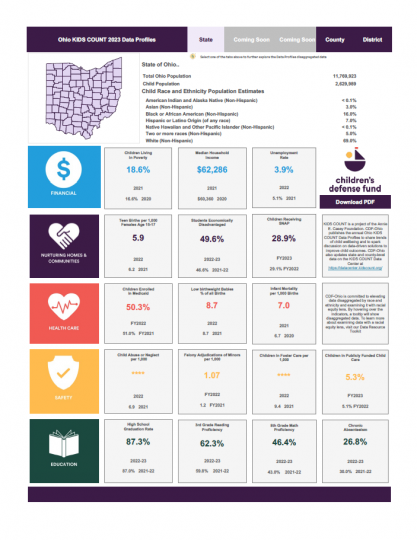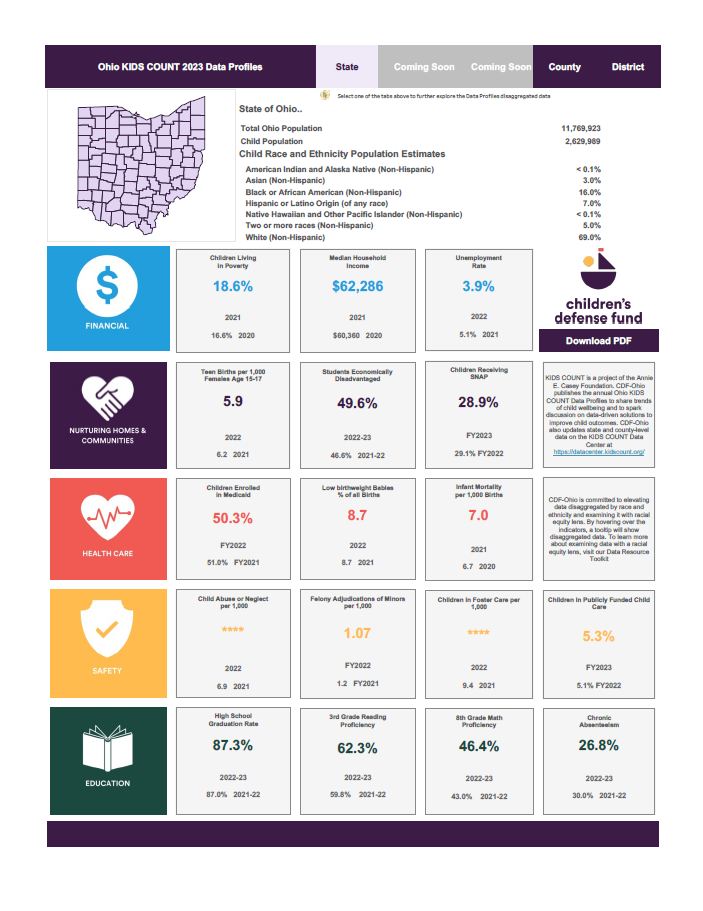Ohio Sits on $11 Billion in Unspent Revenue While Measures of Child Well-being across Ohio are Still Lagging
New 2023 Ohio KIDS COUNT Data Profiles shows that Ohio children are still behind where they were before the pandemic in critical literacy and math proficiencies
COLUMBUS, OH — New 2023 Ohio KIDS COUNT Data Profiles show measures of child wellbeing declining in key areas. The nationwide slide in math and reading proficiency continues to impact Ohio’s students. The percentage of students who are proficient in math and reading recovered slightly in 2022-23 compared to the prior school year but are still well below levels in 2018-2019, before the COVID-19 pandemic forced schools to close. Child advocates urge Ohio leaders to heed the new data and act to ensure Ohio schools and their students are well-supported to alleviate the persistent impacts of learning loss.
Released annually by Children’s Defense Fund-Ohio (CDF-Ohio), the new 2023 KIDS COUNT Data Profiles feature sixteen indicators of child well-being measuring five domains— health care; safety; homes and communities; finance; and education. These profiles offer a comprehensive snapshot of state, county, regional, and school district-level data and give unique insight into areas of opportunity where state leaders can advance policy and funding decisions with ample state resources available to eliminate barriers to well-being for Ohio’s children and youth. State data is also disaggregated by race and ethnicity to show the disparities among children.

“As a state, we have a rare opportunity in front of us,” says Dr. John Stanford with the Children’s Defense Fund-Ohio. “On top of the $3.5 billion in the rainy-day fund, we also have $7.36 billion in unused revenue. The data we are releasing today highlights key areas of need where those unspent dollars can and should be used to expand public programs and services for the benefit of Ohio children and families who need it most.”
Several key metrics demonstrate the clear after-effects of the COVID-19 pandemic and its disruptions on schooling and student learning over the past several years:
- In 2022-23, eighth-grade math proficiency across the state was 46.4%. While this is a small increase from 2021-22 (43%), it is a full 11% percentage points below the rates in 2018-19 (57.3%)
- In 2022-23, third-grade reading proficiency in Ohio was 62.3%, a small increase from 2021-22 (59.8%), but 4% percentage points lower than the rates in 2018-19 (66.7%)
- Chronic absenteeism, defined as a student missing 10% or more of the school year (both excused and unexcused absences), declined from 30% in 2021-22 to 27% in 2022-23, but remained well above the pre-pandemic rates of 17%.
- The percentage of students who are economically disadvantaged followed a slightly different trend. In 2022-23, the percentage increased to 50% up from 47% in 2021-22 and was on par with rates prior to the pandemic of 49% in both 2018-19 and 2019-20. Economic disadvantage is defined as qualifying for free or reduced-price school meals, or income at or below 185% of the federal poverty level
“It’s critical we take stock of all the factors in a child’s life that contribute to positive youth development and educational achievement. Poverty decreases test scores, poor nutrition impacts student engagement, and a lack of access to appropriate health care makes learning more difficult,” says Stanford with CDF-Ohio. “To address these challenges, officials should use excess revenue to fund initiatives such as a state-level child tax credit, universal school meals, increased access to publicly funded childcare, and improved safeguards to ensure consistent and continuous Medicaid coverage. By doing so we will put our students in a better position to succeed not only on a proficiency test today but lifelong.”
As part of Children’s Defense Fund Ohio’s commitment to improving equity and outcomes for all children, we recommend communities across Ohio create robust, community-centered policies by developing a plan to use excess revenue to assist those who are most in need. To do this, decision-makers should:
- Highlight data: Use local data like the KIDS COUNT Data Profiles to inform decisions
- Focus on equity: Use data disaggregated by race and work toward closing gaps
- Engage community voice: Plan public forums, communicate widely and create a process for submitting proposals
- Prioritize child wellbeing: Whole child wellbeing requires communities to invest in their economic stability, health, education, and safety
“To continue to grow and thrive as a state, we must ensure that our children have strong foundations. Doing so will ensure that the current season of excess prevents us from running into a lean season,” says Stanford. “We can prepare for our lean seasons now by investing in the children that will grow into the leaders that see us through those difficulties. We owe it to our children and ourselves to do so.”
To view profiles for the state and each county, click here: 2023 Ohio KIDS COUNT Data Profiles
###
About Children’s Defense Fund-Ohio
Celebrating 50 years in 2023, Children’s Defense Fund envisions a nation where marginalized children flourish, leaders prioritize their well-being, and communities wield the power to ensure they thrive. The only national, multi-issue advocacy organization working at the intersection of child well-being and racial justice, CDF advances the well-being of America’s most diverse generation, the 74 million children and youth under the age of 18 and 30 million young adults under the age of 25. CDF’s grassroots movements in marginalized communities build power for child-centered public policy, informed by racial equity and the lived experience of children and youth. Its renowned CDF Freedom Schools® program is conducted in nearly 100 cities across 30 states and territories. Learn more at www.cdfohio.org

